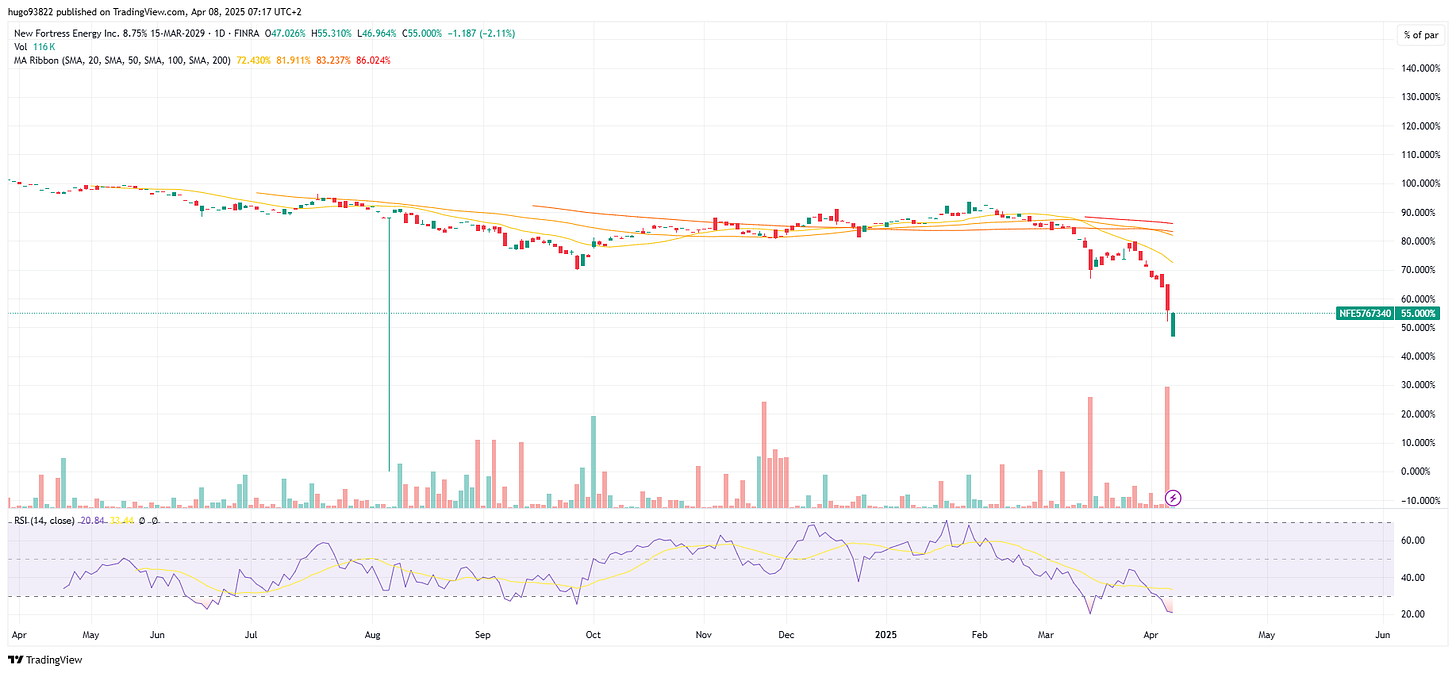I recently completed an in-depth report on New Fortress Energy, a highly leveraged company that many believe is on the brink of bankruptcy. However, despite its challenges, the stock presents a compelling high risk-reward opportunity. Even more attractive are NFE bonds. With exceptionally high yields, these bonds are collateralized against key assets and have priority in the event of a bankruptcy. What's even more enticing is that they are currently priced as if bankruptcy were imminent—a view that, based on my analysis, is entirely unreasonable.
This post is exclusive to paid subscribers. Consider subscribing if you want to learn more about under-covered and undervalued market opportunities.
NFE currently offers two major liquid bonds for trading. My personal favorite is the September 2026 bond, while the March 2029 bond is riskier and less attractive compared to the equity.
New Fortress Energy, 6.5% 30SEP2026, USD (USU6422PAC24)
These bonds were initially issued in an amount of $1.5 billion in 2021. After refinancing two-thirds of this debt, only $510.88 million remains outstanding. They carry a face-value coupon of 6.5%, paid semi-annually, and are currently trading at 68.9—over a 30% discount to par. As these bonds mature in less than a year, they offer a yield to maturity of over 30%, which is enormous.
The key question is: how likely are these bonds to be repaid? In my view, they are almost certain to be paid. Even with a conservative outlook, the company will generate more than enough cash to cover these debts. For example, as I detailed in my previous analysis:
"Looking at the company’s debt wall, NFE must pay $515 million in September bonds by September 2026. From now until mid-next year, it will face interest payments of about $800–$900 million, plus a $100 million credit facility and $540 million in short-term debt. Adding in $200 million for capital expenditures—which is already a conservative estimate (the company expects to secure asset-level financing to offset this)—total payments in the next 18 months could reach approximately $2.155 billion.
On the cash flow side, NFE currently holds $500 million in cash, has received $1.055 billion from the sale of its Jamaican assets, and anticipates an additional $1 billion from Brazil through partial asset sales, an equity stake in FLNG, or vessel disposals. That would bring available funds to around $2.5 billion. Coupled with guidance of about $1 billion in adjusted EBITDA (after deducting core SG&A expenses), and an anticipated additional $800–$900 million from a potential PREPA payment and related financing, the company should comfortably meet its near-term obligations. Clearing this hurdle would extend NFE’s runway until 2029, providing ample time to develop its core operations in Puerto Rico and Brazil and better leverage its assets.
For NFE to fail in meeting this debt wall, it would need to simultaneously be unable to raise the additional $1 billion through asset sales, receive no funds from PREPA or new financing, and generate less than $700 million in EBITDA over the next 18 months. Such a confluence of negative events appears highly unlikely."
Even if current asset sales fall short, NFE possesses additional assets in Nicaragua, FLNG1 (which is fully operational), Mexico, and Puerto Rico that could generate another $1 billion in cash within the next year. Moreover, these bonds are senior secured and therefore sit at the top of the company’s capital structure, providing additional safety in the event of bankruptcy. In terms of risk, the downside is minimal, while the reward is substantial. With the bonds trading at a 30% discount to par, there is an upside of 42% purely from price appreciation. Additionally, with the next coupon payments starting in September 2025, 1.5 years of coupons will yield an extra return, resulting in an IRR hovering around 30%. For me, this represents the best risk-adjusted way to invest in NFE.
Now, let’s briefly examine the riskier bonds.
New Fortress Energy Inc. 8.75% 15-MAR-2029
These bonds trade at a 45% discount to par, offering roughly a 2x return upon reaching par value. With a face-value coupon of 8.75%, current prices imply nearly a 16% yield. Although the bond has just under four years until maturity and a similar IRR to the September bonds, the risks are significantly higher. The company faces a major debt wall in 2029. If it successfully executes two or three of its key initiatives, it might quickly reduce debt and refinance at lower rates for extended terms. However, from a risk-reward perspective, these bonds expose you to risks akin to holding equity, without offering the 10x potential returns that equity might achieve if the company succeeds. While one could argue that some value will be recovered through asset sales in a bankruptcy scenario, recent experiences—such as with the Jamaican assets—indicate that obtaining favorable prices under duress is challenging. I would not want to be in a position where my returns depend solely on asset sales in a bankruptcy.
Conclusion
In summary, I believe the best way to gain exposure to NFE with an attractive risk-reward profile is to invest in the September 2026 bonds, complemented by a position in the company’s shares. This combination offers significant upside while mitigating bankruptcy risk more effectively than the market currently anticipates. Adjust your allocation between bonds and equity based on your risk tolerance and the size of your overall portfolio.
Disclaimer:
The information provided in this article is for informational purposes only and should not be considered financial advice. The content does not constitute a recommendation to buy, sell, or hold any security or investment. Always do your own research and consult with a professional financial advisor before making any investment decisions. Investing in stocks involves risk, including the potential loss of principal. Past performance is not indicative of future results.





